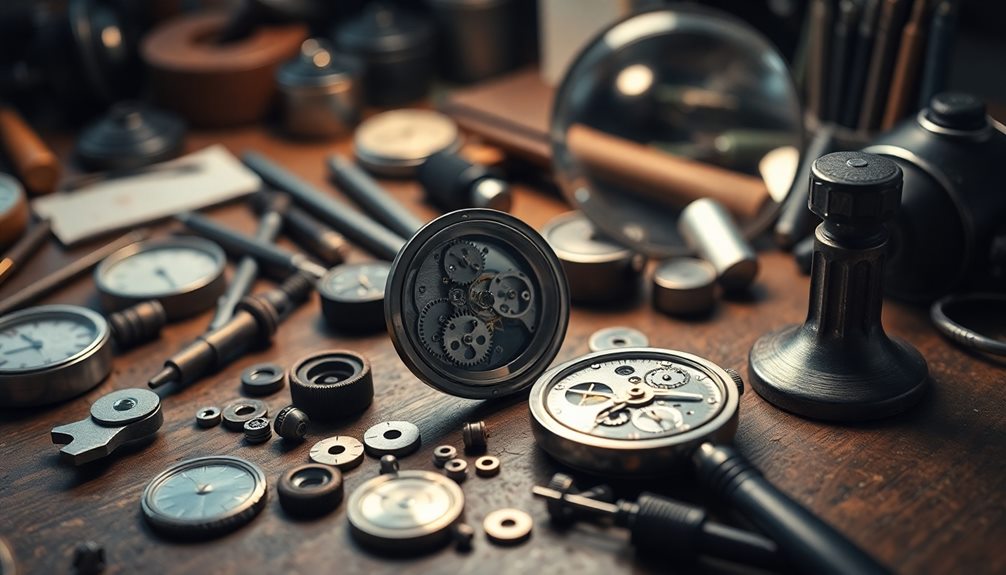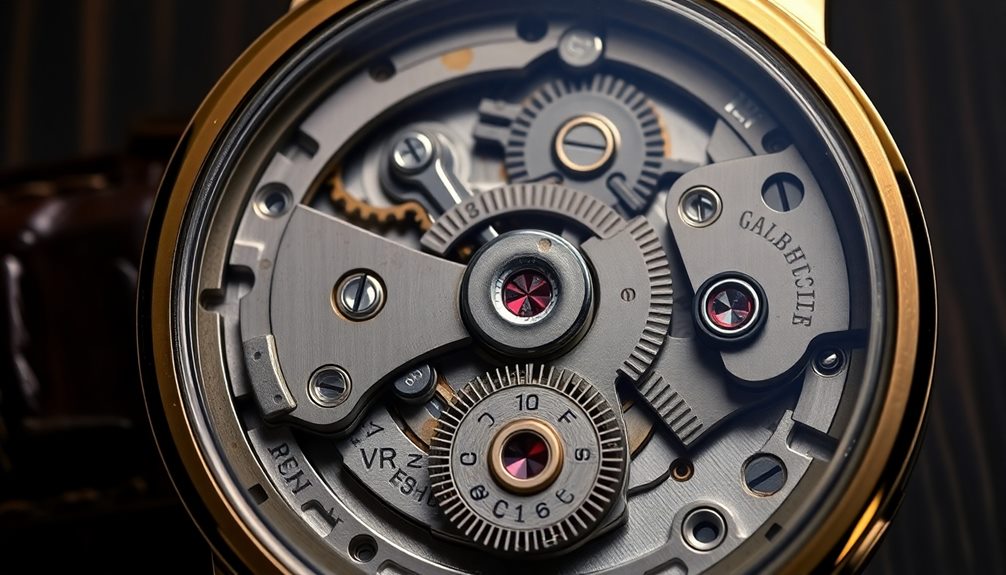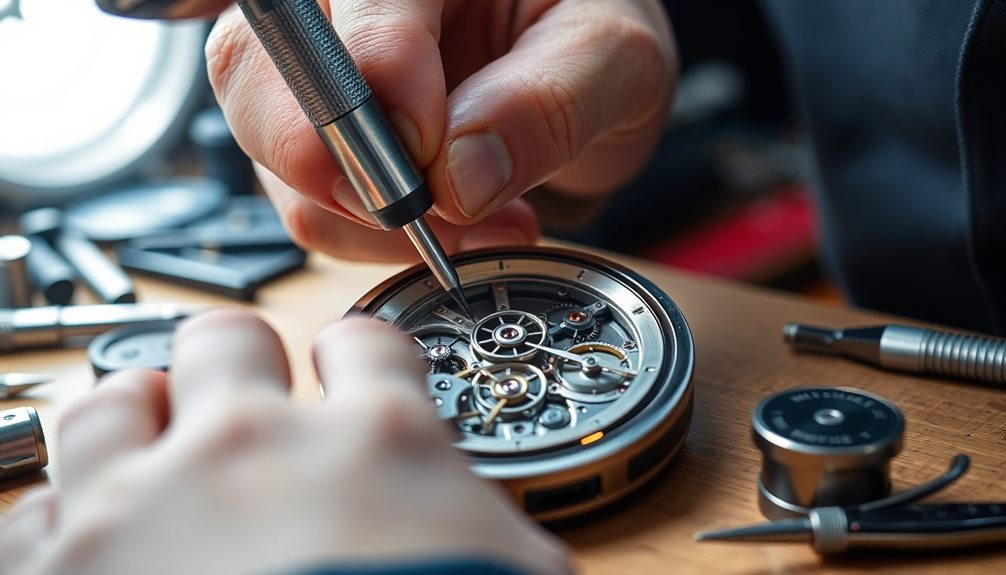Your mechanical watch typically needs servicing every 3-5 years, though vintage pieces may require attention every 2-3 years. You'll know it's time for maintenance when you notice signs like time deviation beyond 5-10 seconds per day, unusual sounds from the movement, or a decrease in power reserve. Daily wear, environmental conditions, and activity level can affect how often you'll need service. While you can perform basic care at home, internal servicing requires a professional watchmaker and costs between $200-$1,500 depending on the brand and complexity. Understanding the full scope of watch maintenance will help protect your timepiece investment.
Table of Contents
Understanding Service Intervals

Mechanical watches typically need servicing every 3-5 years, though this interval can vary based on several factors. If you wear your watch daily, you'll need more frequent servicing than if you only wear it occasionally.
Vintage timepieces often require more attention, sometimes needing service every 2-3 years to maintain peak performance.
You'll want to take into account your watch's specific characteristics when determining service intervals. Higher-end watches with complex movements, like perpetual calendars or chronographs, generally need more frequent maintenance.
The environment where you wear your watch also impacts service timing – exposure to moisture, dust, or magnetic fields can accelerate wear and tear.
Pay attention to your watch's performance indicators. If you notice the timekeeping becoming less accurate, the power reserve decreasing, or the crown feeling rough when winding, it's time for service regardless of the standard interval.
Some manufacturers, like Rolex and Omega, specifically recommend 10-year service intervals for their modern watches, while others suggest more frequent check-ups.
Always consult your watch's manual or the manufacturer's guidelines for specific recommendations.
Signs Your Watch Needs Service
Your watch will signal when it needs attention through several clear warning signs. Even if you haven't reached your typical service interval, you shouldn't ignore these indicators that suggest your timepiece requires professional care.
Think of these signs as your watch's way of communicating potential internal issues before they become more serious problems.
- Your watch is running considerably fast or slow, gaining or losing more than 5-10 seconds per day compared to its normal performance.
- You notice unusual sounds coming from the movement, such as grinding, clicking, or rattling that wasn't present before.
- The crown feels loose, gritty, or resistant when you're winding or setting the time, indicating possible damage to the winding mechanism.
- The power reserve has remarkably decreased, requiring more frequent winding than usual, or the automatic winding function isn't working efficiently.
Additionally, if you spot any moisture under the crystal or experience stiffness in the chronograph functions, don't wait for your regular service interval.
These symptoms often indicate that internal components need immediate attention to prevent further damage to your timepiece's delicate mechanical system.
Factors Affecting Maintenance Frequency

While every mechanical watch requires routine maintenance, several key factors influence how often you'll need to schedule service appointments. Your wearing habits play an essential role – watches worn daily experience more wear than those worn occasionally.
The environment you're in matters too, as exposure to moisture, dust, or extreme temperatures can accelerate the degradation of lubricants and components.
The quality of your watch greatly impacts service intervals. High-end timepieces often use superior materials and more robust construction, potentially extending the time between services.
However, vintage watches typically need more frequent attention due to aging parts and discontinued components.
Your activity level while wearing the watch affects maintenance needs. If you're engaging in sports or physical work, the watch experiences more shock and vibration, potentially requiring earlier service.
The watch's complications also matter – models with additional features like chronographs or perpetual calendars generally need more frequent maintenance than simpler three-hand movements.
Storage conditions between uses can impact service frequency. Proper storage in a watch winder or box helps maintain the lubricants' distribution, while improper storage may lead to oil degradation and increased wear.
Professional Vs DIY Watch Care
When it comes to maintaining mechanical watches, owners often debate between professional servicing and do-it-yourself care.
While DIY maintenance can save money, professional servicing offers expertise and specialized tools that guarantee your timepiece's longevity.
You can perform basic DIY maintenance tasks like cleaning the watch case, adjusting the bracelet, and monitoring timekeeping accuracy.
However, internal servicing should be left to certified watchmakers who can properly disassemble, clean, and lubricate the movement's delicate components.
Here's what professional watchmakers can do that you shouldn't attempt at home:
- Complete movement disassembly and ultrasonic cleaning of all components
- Replacement of worn gaskets, seals, and damaged parts with genuine components
- Precise lubrication of jewels and gear trains using specific oils for each part
- Proper water-resistance testing using specialized equipment
You'll need to balance the cost of professional servicing against the risk of damaging your watch through DIY attempts.
While routine external care is perfectly fine for watch owners, anything involving the movement's internals requires professional expertise.
Remember that improper DIY repairs can void your warranty and potentially cause more expensive damage.
Cost of Watch Servicing

The cost of servicing a mechanical watch varies greatly depending on the brand, model complexity, and required repairs. For basic servicing of entry-level mechanical watches, you'll typically spend between $200 to $400.
However, luxury brands like Rolex, Omega, or Patek Philippe can cost anywhere from $600 to over $1,500 for routine maintenance.
The service cost usually covers disassembly, cleaning, lubrication, regulation, and basic parts replacement like gaskets. If your watch needs additional repairs or replacement parts, you'll pay extra.
Complex complications like chronographs or perpetual calendars also increase the service price considerably.
You'll find that authorized service centers for luxury brands charge premium rates, while independent watchmakers often offer more competitive pricing.
However, using unauthorized repair services might affect your warranty and resale value.
It's worth noting that some high-end manufacturers require sending your watch to their specialized facilities, which can add shipping and insurance costs to your total.
To manage these expenses, you should budget annually for watch maintenance, setting aside roughly 10% of your watch's retail value for future servicing needs.
Frequently Asked Questions
Can Water Resistance Be Compromised Between Regular Service Intervals?
Yes, your watch's water resistance can be compromised between services due to aging gaskets, accidental crown damage, impacts, or temperature changes. You'll want to test water resistance annually, even before regular service intervals.
Does Magnetization of a Watch Movement Affect the Service Schedule?
No, magnetization doesn't affect your service schedule. While you'll need to demagnetize your watch when it runs fast or erratic, this is a separate issue from regular maintenance and timing adjustments.
Should Vintage Watches Follow the Same Maintenance Schedule as Modern Ones?
You'll want to service vintage watches more frequently than modern ones, as they're typically more fragile and use older materials. Plan on maintenance every 3-4 years instead of the 5-7 years for contemporary timepieces.
Can Changing Time Zones Frequently Impact a Watch's Service Needs?
You won't need extra servicing just from changing time zones. Your watch's movement is designed to handle time adjustments. Just verify you're adjusting the time correctly by following your watch's manual instructions.
Does Storing Watches in a Winder Reduce the Need for Servicing?
No, watch winders won't reduce your service needs. While they'll keep your watch running and save you from resetting complications, they don't prevent lubricant breakdown or mechanical wear that makes servicing necessary.
In Summary
Regular servicing of your mechanical watch isn't just about maintaining its value – it's essential for keeping accurate time and preventing costly damage. You'll want to schedule professional maintenance every 3-5 years, but don't ignore warning signs that could indicate earlier service needs. By staying proactive with your watch care and working with qualified watchmakers, you'll enjoy your timepiece's precision and beauty for generations.
As a professional trainer and a gadget lover, I’ve spent a lot of money and time buying wearable activity trackers, smartwatches, and gadgets, and checking them out. My site is focused on helping you with your activity tracking and smart technology journey. I try to provide the most helpful updated content on this subject. Hopefully, you will love my blogs and be a regular around here.



